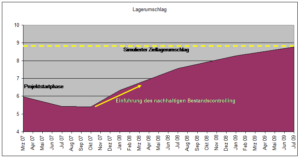Surgical suture material is one of the products manufactured at Serag-Wiessner. Short delivery times are a must. However, the necessary planning and procurement processes are no less complexly interwoven than the manufactured products. Thanks to supply chain optimization, it has been possible to sustainably improve the balancing act between the opposing target values.
Serag-Wiessner produces and supplies surgical suture material, textile implants for the pelvic floor and infusion solutions (Fig. 1). Of the approx. 3,000 items in the division, approx. 1,500 items are to be stocked from the dispatch warehouse. The approximately 25,000 customers expect a delivery time of 24 to 48 hours. To meet these requirements, stocks are held in the finished goods warehouse, which were previously dimensioned by planners and dispatchers on the basis of ERP order proposals.
In the past, however, attempts to significantly reduce stocks by our own efforts have not led to the desired success. The management therefore decided to entrust external supply chain specialists with this task in order to find a sustainable solution. In addition to the sales-oriented target figures – delivery times of 24 to 48 hours and an average target delivery readiness of 96% – the planning parameters had to ensure that the production orders and the associated set-up processes were limited to 1,200 per month.

Check the current status
The project began with an inventory of the current processes and logistics parameters such as range, delivery readiness and stock turnover. The ERP system based on an “AS400” platform from SoftM, which is used at Serag-Wiessner, was also put to the test. Although it has basic scheduling and forecasting functions, these were not sufficient to achieve the targets. The management therefore decided to purchase the missing functionality via the “Diskover SCO” optimization tool from SCT GmbH. The software features simulation-based optimization of scheduling parameters, extensive forecasting and safety procedures and integrated inventory controlling.
Finding solutions
First of all, differentiated simulations were used to determine the influences of delivery readiness, stocks and set-up costs. It quickly became clear that only differentiated approaches would lead to the goal. Different target delivery readiness levels were therefore defined for different product groups, for example: higher ranges were selected for the batch sizes for low-value C articles than for the high-turnover A articles. Ultimately, a set of rules in the form of a decision table was created as part of the concept, which took into account the criteria of the ABC and XYZ labels as well as the shelf life and market requirements of the various product groups. This set of rules was mapped in the “Diskover SCO” and can be flexibly adapted.

The implementation and its results
As part of the simulations, the achievable target values could be determined in advance (Figure 2). However, the results did not materialize at the beginning of the implementation phase. The breakthrough only came when daily inventory controlling was implemented: After each day, stocks, sales, stock turnover and readiness for delivery are compared with the currently simulated target figures. In the case of delivery readiness, a distinction is even made between different time periods (7 days and 30 days) in order to be able to better assess the short-term development of delivery capability. This report is sent daily by e-mail to the dispatchers and management. This allows you to react quickly in the event of major deviations and take countermeasures if necessary.
In cooperation with Abels & Kemmner, Serag-Wiessner was able to reduce its stock to 65 percent. In addition, stock turnover increased so that the average storage period was optimized to around 6 weeks. At the same time, delivery readiness was improved to 96% and will be maintained on an ongoing basis. The 35% reduction in inventories released corresponding liquidity reserves. The company is now actively using this idle capital in the warehouse to further strengthen its competitiveness. At the same time, this results in annual cost savings of 15 percent or more in most companies.

